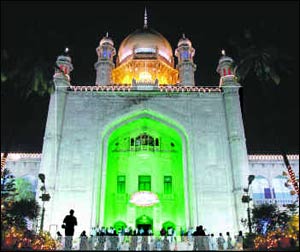»
Tourist Spots » High CourtHigh Court

Deepa Menon / fullhyd.com
Vincent was a serious young man. Except when someone mentioned onions. Then his face would light up like a Christmas tree and he would jump up and down in excitement. This got to be very awkward once he turned 21, but young Vincent Esch wasn't the slightest bit perturbed by strange looks. He had cities to plan and monuments to immortalize. Onions, though, remained a special passion. More on that later.
Vincent was one of the few British architects hired to work on pre-Independent India's emerging urban landscape. After he got Kolkata's Victoria Memorial Hall on his resume (as a Construction Supervisor), he was snapped up by the seventh Nizam to help reconstruct Hyderabad. And that was when the High Court came into existence on the banks of the now sludge-like river Musi. Along with it there appeared at random intervals in the city, the Railway Station, the City High School and Osmania Hospital. All in the signature style of Vinny Esch.
But the High Court remains a class apart. And not just because it cost a bomb (two million rupees in those days was an astronomical sum, and still is for some of us - pink granite, after all, is not cheap, and neither are carved red sand stone pillars). The High Court, unlike the rotund little forts and palaces that surrounded it, was built in the Perpendicular Moghul-Saracenic style, which translated into elegant onion-shaped domes that stretched languorously to the sky.
Very unusual, very picturesque, and very difficult to get into unless you're a lawyer. If you want to take a keener look at the High Court, you must contact the Department of Tourism for special permission. Calling 2345-2492 is a good place to start.
Vincent was one of the few British architects hired to work on pre-Independent India's emerging urban landscape. After he got Kolkata's Victoria Memorial Hall on his resume (as a Construction Supervisor), he was snapped up by the seventh Nizam to help reconstruct Hyderabad. And that was when the High Court came into existence on the banks of the now sludge-like river Musi. Along with it there appeared at random intervals in the city, the Railway Station, the City High School and Osmania Hospital. All in the signature style of Vinny Esch.
But the High Court remains a class apart. And not just because it cost a bomb (two million rupees in those days was an astronomical sum, and still is for some of us - pink granite, after all, is not cheap, and neither are carved red sand stone pillars). The High Court, unlike the rotund little forts and palaces that surrounded it, was built in the Perpendicular Moghul-Saracenic style, which translated into elegant onion-shaped domes that stretched languorously to the sky.
Very unusual, very picturesque, and very difficult to get into unless you're a lawyer. If you want to take a keener look at the High Court, you must contact the Department of Tourism for special permission. Calling 2345-2492 is a good place to start.
HIGH COURT SNAPSHOT
-
Listed In
-
Address
-
Telephone
-
Distance4.3 km (Maps & Directions)
-
Year Started
-
Timings
-
Closed On
-
Payment Option(s)
-
Closest Bus Stop
-
Closest MMTS Station
-
Add New Field:
EVENTS AT HIGH COURT
There are no events at High Court scheduled currently.
HIGH COURT USER REVIEWS
Be the first to comment on High Court! Just use the simple form below.
LEAVE A COMMENT
fullhyd.com has 700,000+ monthly visits. Tell Hyderabad what you feel about High Court!
RELATED LISTINGS
Near Saint Joseph's Public School, Malakpet (2.9km)
Moosarambagh (6.3km)
Ramoji Film City, R R District, Hyderabad-Vijayawada Highway (3.6km)
1-8-323, Police Lines, Begumpet (1.3km)
Golconda (7.3km)
RELATED CATEGORIES
SEARCH YELLOW PAGES
Dissatisfied with the results? Report a problem or error, or add a listing.
ADVERTISEMENT
SHOUTBOX!
{{ todo.summary }}... expand »
{{ todo.text }}
« collapse
First | Prev |
1 2 3
{{current_page-1}} {{current_page}} {{current_page+1}}
{{last_page-2}} {{last_page-1}} {{last_page}}
| Next | Last
{{todos[0].name}}
{{todos[0].text}}
ADVERTISEMENT
This page was tagged for
afzalgung aunty contact number
hyd high court interior pics
food court in afzalgunf
tourist attractions in hyderabad pakistan
hyderabad high court address with map